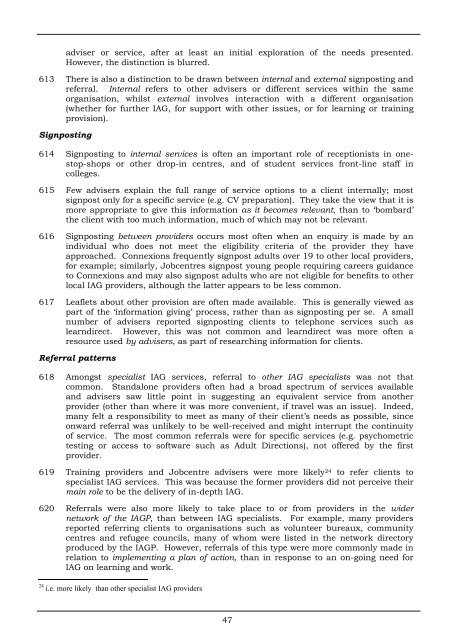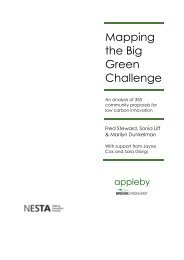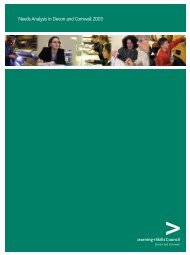Client needs for coherent information, advice and guidance services ...
Client needs for coherent information, advice and guidance services ...
Client needs for coherent information, advice and guidance services ...
You also want an ePaper? Increase the reach of your titles
YUMPU automatically turns print PDFs into web optimized ePapers that Google loves.
adviser or service, after at least an initial exploration of the <strong>needs</strong> presented.<br />
However, the distinction is blurred.<br />
613 There is also a distinction to be drawn between internal <strong>and</strong> external signposting <strong>and</strong><br />
referral. Internal refers to other advisers or different <strong>services</strong> within the same<br />
organisation, whilst external involves interaction with a different organisation<br />
(whether <strong>for</strong> further IAG, <strong>for</strong> support with other issues, or <strong>for</strong> learning or training<br />
provision).<br />
Signposting<br />
614 Signposting to internal <strong>services</strong> is often an important role of receptionists in onestop-shops<br />
or other drop-in centres, <strong>and</strong> of student <strong>services</strong> front-line staff in<br />
colleges.<br />
615 Few advisers explain the full range of service options to a client internally; most<br />
signpost only <strong>for</strong> a specific service (e.g. CV preparation). They take the view that it is<br />
more appropriate to give this in<strong>for</strong>mation as it becomes relevant, than to ‘bombard’<br />
the client with too much in<strong>for</strong>mation, much of which may not be relevant.<br />
616 Signposting between providers occurs most often when an enquiry is made by an<br />
individual who does not meet the eligibility criteria of the provider they have<br />
approached. Connexions frequently signpost adults over 19 to other local providers,<br />
<strong>for</strong> example; similarly, Jobcentres signpost young people requiring careers <strong>guidance</strong><br />
to Connexions <strong>and</strong> may also signpost adults who are not eligible <strong>for</strong> benefits to other<br />
local IAG providers, although the latter appears to be less common.<br />
617 Leaflets about other provision are often made available. This is generally viewed as<br />
part of the ‘in<strong>for</strong>mation giving’ process, rather than as signposting per se. A small<br />
number of advisers reported signposting clients to telephone <strong>services</strong> such as<br />
learndirect. However, this was not common <strong>and</strong> learndirect was more often a<br />
resource used by advisers, as part of researching in<strong>for</strong>mation <strong>for</strong> clients.<br />
Referral patterns<br />
618 Amongst specialist IAG <strong>services</strong>, referral to other IAG specialists was not that<br />
common. St<strong>and</strong>alone providers often had a broad spectrum of <strong>services</strong> available<br />
<strong>and</strong> advisers saw little point in suggesting an equivalent service from another<br />
provider (other than where it was more convenient, if travel was an issue). Indeed,<br />
many felt a responsibility to meet as many of their client’s <strong>needs</strong> as possible, since<br />
onward referral was unlikely to be well-received <strong>and</strong> might interrupt the continuity<br />
of service. The most common referrals were <strong>for</strong> specific <strong>services</strong> (e.g. psychometric<br />
testing or access to software such as Adult Directions), not offered by the first<br />
provider.<br />
619 Training providers <strong>and</strong> Jobcentre advisers were more likely 24 to refer clients to<br />
specialist IAG <strong>services</strong>. This was because the <strong>for</strong>mer providers did not perceive their<br />
main role to be the delivery of in-depth IAG.<br />
620 Referrals were also more likely to take place to or from providers in the wider<br />
network of the IAGP, than between IAG specialists. For example, many providers<br />
reported referring clients to organisations such as volunteer bureaux, community<br />
centres <strong>and</strong> refugee councils, many of whom were listed in the network directory<br />
produced by the IAGP. However, referrals of this type were more commonly made in<br />
relation to implementing a plan of action, than in response to an on-going need <strong>for</strong><br />
IAG on learning <strong>and</strong> work.<br />
24 i.e. more likely than other specialist IAG providers<br />
47











